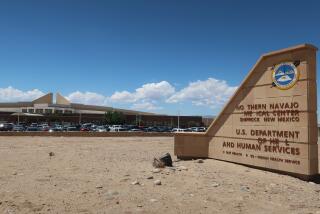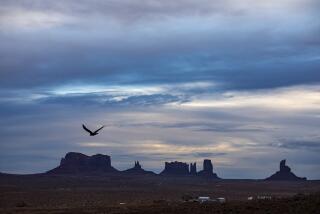Navajos Have No Reservations on Latest in Digital Computer Phones
- Share via
CHINLE, Ariz. — Navajos’ disdain of community living has long given fits to an industry whose trademark is poles stretching to the horizon.
Where people live close together, the traditional telephone system works fine, but when they are scattered most companies can’t justify the cost, said Francis Mike, general manager of Navajo Communications Co. “Navajos don’t live in large clusters. They live miles apart.”
For Suzie Randall, that meant a 12-mile trek from her home in Nazlini to Chinle every two to three weeks for the last 21 years to call her daughters in Denver and Ft. Defiance, followed by a 12-mile return trip.
The old days and the new now meet at the 79-year-old Randall’s one-room house. Sheepskins dry in a shade house out front. Hugging the back wall, looking like a giant mushroom beside an inverted carrot, are a satellite dish for TV reception and a box-like transceiver for Ultraphone, a system that is bringing telephone service to the Navajos using radio instead of cables, for about one-eighth the cost.
Wyoming System
International Mobile Machines Corp. of Philadelphia began working on what would become Ultraphone in 1981. Its first installation was in September of 1986, for Mountain Bell in the Douglas, Wyo., area.
Last November, the Federal Communications Commission decided that the time had come for radio to improve rural phone service, organized a Basic Exchange Telecommunications Radio Service and allocated frequency channels to it.
Twenty companies or groups are investigating or have installed Ultraphone from St. Lawrence County, N.Y., to the sparsely populated Southwest, Mike said. Navajo Communications introduced it in November on the 25,000-square-mile reservation, a West Virginia-sized area that is home to 175,000 people.
Now, demand exceeds supply, he said. Navajos are “up on technology. They all have television, and now they’d like phones. They’re coming in here and saying: ‘We want telephone service now.’ ”
The key to Ultraphone is digital radio technology, using an encoder to convert voices into the computer, or binary, language for transmission as a radio signal. Beamed to a tower atop a mesa nine miles from Chinle, the signal is relayed to destination, where it is decoded by a transceiver. Users converse over standard telephones--the magic is in the means, not the end.
37 1/2-Mile Radius
The signal covers a circle with a radius of 37 1/2 miles, so customers have the benefit of being able to make a 75-mile local call. Bills run $15 to $23 per month for basic service, Mike said.
That presents a unique challenge for Cecil Jones, Navajo Communications’ Chinle service area manager, whose job runs the gamut from marketing to helping customers make out checks to pay for the service.
“I have to sit down and explain what a telephone bill is,” he said. “It’s very educational for us, really something we need to do as a person. The other thing is to explain to them the capabilities of the equipment--the difference between a local call and long distance.”
Navajo Communications has invested about $750,000 in the system, which currently has about 100 customers of 460 possible. Jones estimated that it would cost at least $6 million to run wires into the same clusters of dwellings.
The company plans to cover most of the reservation--most of northeastern Arizona and parts of Utah and New Mexico--with installations in its three other service areas, based in Window Rock and Tuba City, Ariz., and Shiprock, N.M.
Ultraphone is the only digital system on the market, said IMM spokeswoman Marcia Bexley. It offers improved transmission quality and the ability to time-divide a radio channel to allow four simultaneous conversations.
“The big thing is spectrum efficiency. We make the most out of the radio spectrum,” Bexley said.
“It relates to the cost, because in radio, channels are the cost,” said IMM regional director Kris Shelton in Denver, who added that the digital format ensures privacy. “With a normal mobile radio, you can sit with a broadcast scanner and listen in; with digital, all you hear is a hissing sound.”
But spectrum efficiency, signal splitting and security aren’t the important things to Suzie Randall. “I really like the service and it’s a communication I have with my kids,” she said in Navajo, translated by Jones.
The only problem, she said, is neighbors who have no phones turning up with increasing frequency to make calls.
More to Read
Sign up for Essential California
The most important California stories and recommendations in your inbox every morning.
You may occasionally receive promotional content from the Los Angeles Times.













